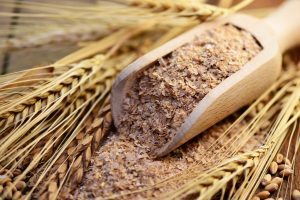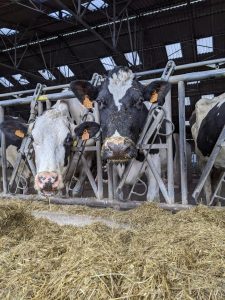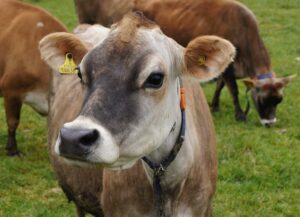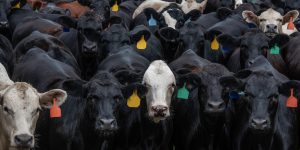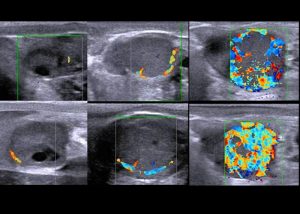Álvaro García
Note: U.S. units are used throughout this article. Metric equivalents are provided in parentheses for international readers.
Corn grain typically makes up 30 to 35% of the total mixed ration (TMR) dry matter in a Midwestern lactating cow diet. Because of this, fluctuations in corn prices can have a major impact on overall feed costs. In recent years, corn prices have remained volatile, driven by weather events, global demand, ethanol production, and other factors. Corn has long been the primary energy source in dairy cow diets, valued for its high starch content and its ability to support energy-dense formulations required by modern, high-producing cows. As of this article, corn prices are averaging around $4.77 per bushel ($188 per ton), a level that still weighs heavily on feed budgets, particularly when combined with rising prices for soybeans and alfalfa hay. As a result, dairy producers must constantly adjust rations to balance cow energy needs with economic realities.
Milk feed price ratio
The milk-feed price ratio helps dairy farmers understand how much feed they can afford to buy to produce a pound (0.45 kg) of milk. When this ratio is 3.0 or higher, it usually makes sense to invest in better feed to boost production.
The basic idea is simple:
- Higher milk prices help justify better (and sometimes more expensive) feeding.
- Lower milk prices or high feed costs, force farmers to tighten rations.
To estimate the cost of feed required to produce milk, the USDA uses a standard formula based on a blend of corn, soybeans, and alfalfa hay that would provide about 16% crude protein (CP), a typical concentration for lactating dairy cow diets. The formula applies set quantities of each ingredient, reflecting their roles in providing energy, protein, and fiber.
(Corn price per bushel / 56) x 50 + (Soybean price per bushel / 60) x 8 + (Alfalfa hay price per ton / 2000) x 41
Where:
- 56 lbs. = weight of a bushel of corn
- 60 lbs. = weight of a bushel of soybeans
- 2000 lbs. = weight of a ton
- The numbers 50, 8, and 41 are pounds of each ingredient used to create a “standard” 99 lb. feed blend that is approximately 16% CP.
The milk-feed price ratio helps dairy farmers understand how much feed they can afford to buy to produce a pound (0.45 kg) of milk. When this ratio is 3.0 or higher, it usually makes sense to invest in better feed to boost production. When the ratio falls below that level, feed costs start eroding profitability, and farmers must look for ways to reduce expenses.
Based on 2025 commodity data:
- Corn: $4.77/bu (~$188/ton)
- Soybeans: $10.67/bu (~$406/ton)
- Alfalfa hay: $220/ton (~$242/metric ton)
- Milk: $21.10/cwt (~$0.46/kg)
Applying these prices gives a milk-feed price ratio of approximately 2.07 which means that even though milk prices have risen, feed costs remain a significant burden for dairy producers.
Methane emissions
When grain prices go up, it is natural for farmers and nutritionists to look for ways to feed more forage and less corn. While this can help save money, it also leads to lower energy density in the ration. As a result cows may need to eat more feed just to meet their needs for maintenance and milk production.
Here’s a simple example:
- A cow eating 45 pounds (20.4 kg) of dry matter from a balanced TMR providing 0.77 megacalories (Mcal) of net energy for lactation (NEL) per pound (1.70 Mcal/kg) ingests about 35 Mcal of NEL each day.
- If the ration energy drops to 0.69 Mcal/lb (1.52 Mcal/kg), the cow would need to eat 50 pounds (22.7 kg) just to get the same 35 Mcal of energy from the feed.
That extra intake can lead to unintended consequences: the more a cow eats, the more methane she produces. Ellis et al. (2007) developed a model to predict the relationship between dry matter intake and methane production, expressed as:
Methane (MJ/day) = 3.23 + 0.81 × Dry Matter Intake (kg/day)
So even if a cow maintains milk yield, more forage intake can mean more methane emissions.
Today, farmers have additional tools to tackle methane emissions beyond ration adjustments. Feed additives like 3-nitrooxypropanol (3-NOP) can inhibit methane production directly in the rumen, achieving reductions of up to 40% without lowering milk output. Other options, such as feeding small amounts of Asparagopsis seaweed, have shown even larger reductions under experimental conditions. While these technologies are not yet widespread on every farm, they offer exciting possibilities for the future.
At the same time, research shows that improving feed efficiency remains one of the most powerful ways to lower methane emissions per liter of milk. The average U.S. dairy cow produces about 0.33 MJ of methane per pound (0.73 MJ/kg) of milk (Garcia and Linn, 2008). Increasing the energy a cow gets from each bite of feed can help move that number even lower.
Feed efficiency and forage quality
Efficiency or how much milk a cow produces for every pound or kilogram of feed she eats — has become a critical sustainability metric worldwide. Today, environmental footprints are measured not just by how much methane a cow emits, but how much she emits per liter of milk produced (emission intensity). Higher-producing cows, even though they eat more and produce more methane each day, have lower “emissions intensity”.
“It’s not just about reducing emissions from each cow, it’s about making each cow more efficient, so fewer cows are needed to produce the same amount of milk.”
And when it comes to improving efficiency, forage quality plays a key role. If cows can get more energy from forage, they need less supplemental grain. Better forage quality means better feed conversion, higher milk yields, and lower methane emissions per liter of milk.
One of the biggest factors influencing forage quality is the digestibility of corn silage, which remains a major forage source in most dairy diets. Analysis from approximately 30,000 corn silage samples (Table 1) shows how widely forage quality can vary, especially in terms of dry matter digestibility and starch content. Understanding this variation is critical because higher digestibility directly supports better feed efficiency and lower methane emissions per unit of milk produced.
Table 1. Range in corn silage quality (based on ~30,000 Samples) |
||
|
Quality |
Dry Matter Digestibility %) |
Starch Content (%) |
|
Poor |
< 58% |
< 28% |
|
Average |
58–63% |
28–34% |
|
Good |
63–68% |
34–38% |
|
Excellent |
> 68% |
> 38% |
|
Adapted from Jones et al., 2011. |
||
One big advancement in modern forage technology is the use of brown midrib (BMR) corn silage hybrids. BMR varieties have lower lignin content, leading to higher fiber digestibility. Feeding BMR corn silage helps cows eat more forage, get more energy from it, and produce milk more efficiently, all while helping reduce enteric methane emissions. For farms looking to boost sustainability without sacrificing milk production, BMR hybrids are an excellent tool.
Feed costs and environmental sustainability have become closely linked challenges for dairy producers. Managing feed efficiency by optimizing forage digestibility, reducing dependence on expensive grains, and maintaining high-energy diets remains critical not only for profitability but also for lowering methane emissions per liter of milk produced.
New tools like 3-NOP and BMR corn hybrids give producers more options than ever to address both economic and environmental goals. As the global dairy industry moves toward net-zero carbon targets by 2050, improvements in feed management, forage quality, and enteric methane reduction will be crucial.
© 2025 Dellait Knowledge Center. All Rights Reserved.




